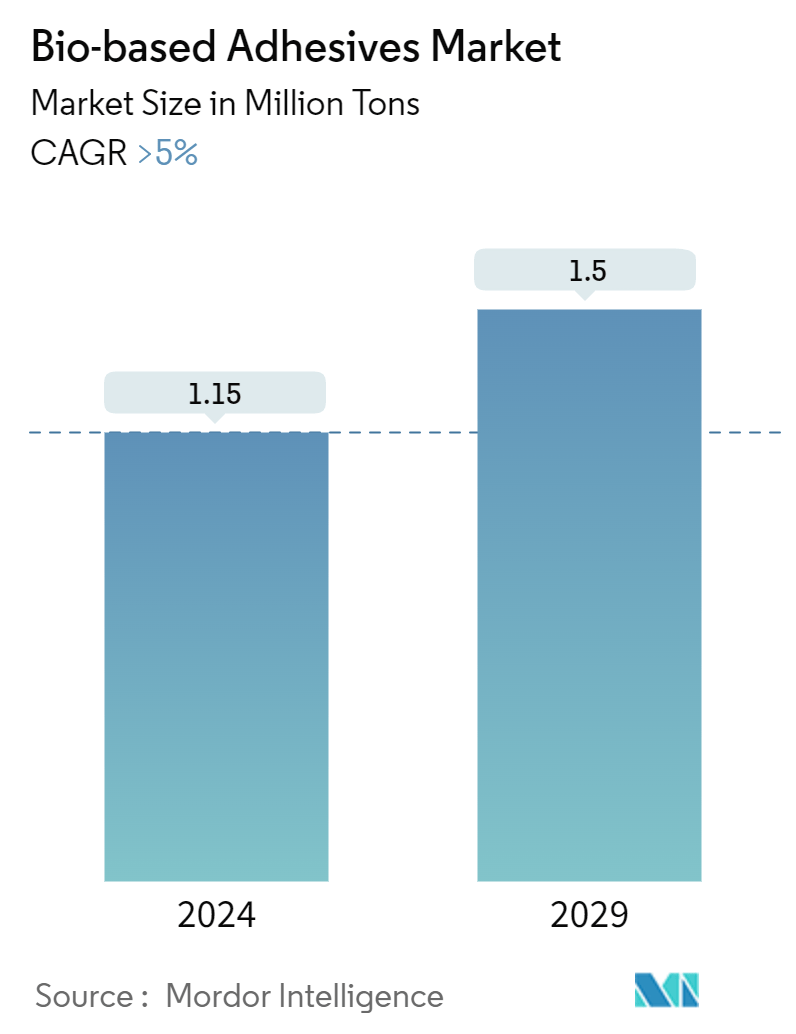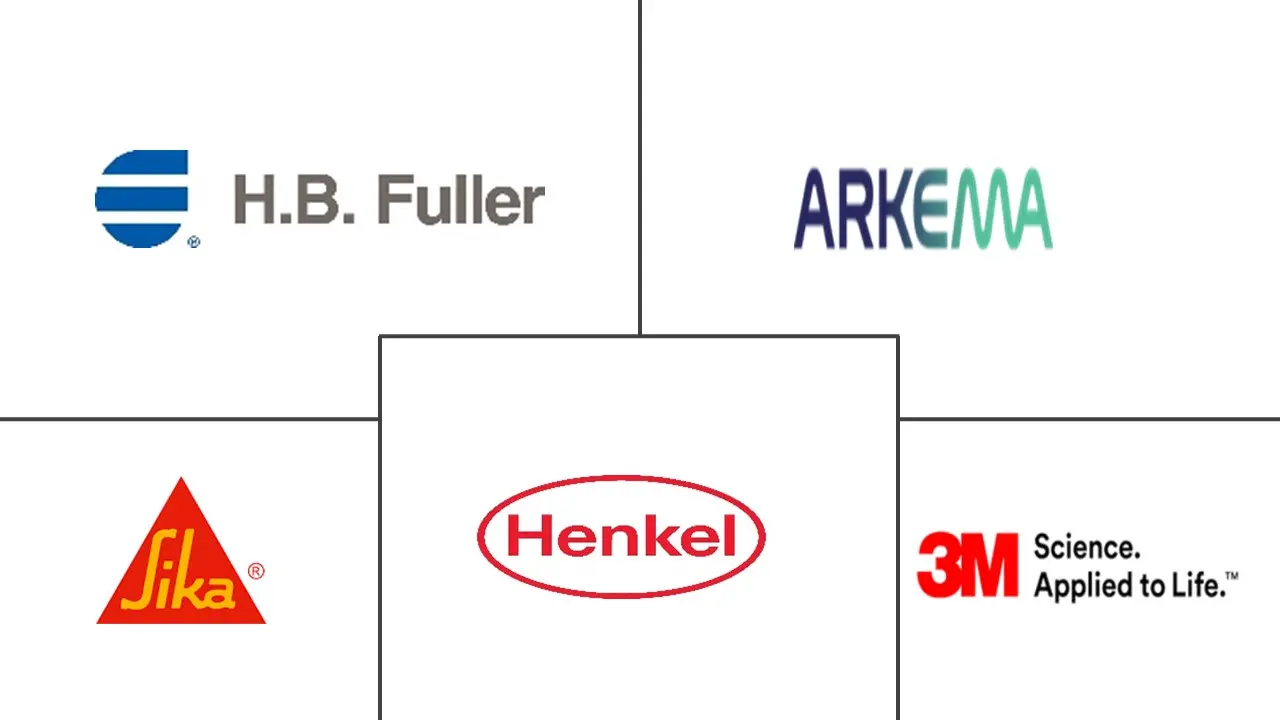Market Size of Bio-based Adhesives Industry

| Study Period | 2019 - 2029 |
| Market Volume (2024) | 1.15 Million tons |
| Market Volume (2029) | 1.5 Million tons |
| CAGR (2024 - 2029) | > 5.00 % |
| Fastest Growing Market | Asia Pacific |
| Largest Market | Europe |
| Market Concentration | Low |
Major Players
*Disclaimer: Major Players sorted in no particular order |
Bio-based Adhesives Market Analysis
The Bio-based Adhesives Market size is estimated at 1.15 Million tons in 2024, and is expected to reach 1.5 Million tons by 2029, growing at a CAGR of greater than 5% during the forecast period (2024-2029).
- The increasing demand from the packaging sector and the stringent regulations for conventional adhesives in the United States are two main factors driving the market growth.
- However, the low shelf life and performance hindrance of bio-based additives compared to petroleum-based additives is likely to hinder market growth.
- Nevertheless, the growing modular construction activities are likely to provide growth opportunities for the market over the short term.
- Europe dominates the bio-based adhesives market across the world and is likely to witness the highest growth rate during the forecast period.
Bio-based Adhesives Industry Segmentation
Bio-based adhesives are adhesive formulations derived from renewable resources such as plant-based materials, offering an eco-friendly alternative to traditional adhesives that are often petroleum-based. These adhesives are designed to provide bonding properties while minimizing environmental impact; this aligns with sustainability and green manufacturing practices.
The bio-based adhesives market is segmented by raw materials, end-user industry, and geography. By raw materials, the market is segmented by rosin, starch, lignin, and soy (polylactic acid and seaweed). By end-user industry, the market is segmented into building and construction, paper, board, and packaging, healthcare, personal care, woodworking and joinery, and other end-user industries. The report also offers market sizes and forecasts for 27 countries across major regions. For each segment, market sizing and forecasts were made based on volume (kilotons).
| Raw Materials | |
| Rosin | |
| Starch | |
| Lignin | |
| Soy | |
| Other Raw Materials |
| End-user Industry | |
| Building and Construction | |
| Paper and Board Packaging | |
| Healthcare | |
| Personal Care | |
| Woodworking and Joinery | |
| Other End-user Industries |
| Geography | |||||||
| |||||||
| |||||||
| |||||||
| |||||||
|
Bio-based Adhesives Market Size Summary
The bio-based adhesives market is poised for significant growth, driven by increasing demand from the packaging sector and stringent regulations on conventional adhesives, particularly in the United States. Despite challenges such as the limited shelf life and performance issues compared to petroleum-based alternatives, the market is expected to benefit from the rise in modular construction activities. Europe leads the global market, with countries like Germany and the United Kingdom contributing significantly to its dominance. The region is anticipated to maintain its leadership and experience the highest growth rate during the forecast period, supported by advancements in bio-succinic acid production and a strong presence of major adhesive companies.
Bio-based adhesives are becoming increasingly integral across various industries, including food and beverage, construction, healthcare, and personal care, due to their sustainable and environmentally friendly properties. The packaging industry, in particular, is a major consumer, with the rising demand for organic food and improved living standards boosting the need for bio-based adhesives. In Europe, the construction sector's growth and the healthcare industry's investment in biocompatible solutions further enhance market prospects. The global market remains fragmented with intense competition among key players like Henkel AG & Co. KGaA, H.B. Fuller, Arkema, Sika, and 3M, who are actively shaping the industry's landscape.
Bio-based Adhesives Market Size - Table of Contents
-
1. MARKET DYNAMICS
-
1.1 Drivers
-
1.1.1 Increasing Demand from Packaging Sector
-
1.1.2 Stringent Regulations for Conventional Adhesives in the United States
-
1.1.3 Other Drivers
-
-
1.2 Restraints
-
1.2.1 Low Shelf Life and Performance in Comparison to Petroleum-based Adhesives
-
1.2.2 Other Restraints
-
-
1.3 Industry Value Chain Analysis
-
1.4 Porter's Five Forces Analysis
-
1.4.1 Bargaining Power of Suppliers
-
1.4.2 Bargaining Power of Consumers
-
1.4.3 Threat of New Entrants
-
1.4.4 Threat of Substitute Products and Services
-
1.4.5 Degree of Competition
-
-
-
2. MARKET SEGMENTATION
-
2.1 Raw Materials
-
2.1.1 Rosin
-
2.1.2 Starch
-
2.1.3 Lignin
-
2.1.4 Soy
-
2.1.5 Other Raw Materials
-
-
2.2 End-user Industry
-
2.2.1 Building and Construction
-
2.2.2 Paper and Board Packaging
-
2.2.3 Healthcare
-
2.2.4 Personal Care
-
2.2.5 Woodworking and Joinery
-
2.2.6 Other End-user Industries
-
-
2.3 Geography
-
2.3.1 Asia-Pacific
-
2.3.1.1 China
-
2.3.1.2 India
-
2.3.1.3 Japan
-
2.3.1.4 South Korea
-
2.3.1.5 Rest of Asia-Pacific
-
-
2.3.2 North America
-
2.3.2.1 United States
-
2.3.2.2 Canada
-
2.3.2.3 Mexico
-
-
2.3.3 Europe
-
2.3.3.1 Germany
-
2.3.3.2 United Kingdom
-
2.3.3.3 France
-
2.3.3.4 Italy
-
2.3.3.5 Rest of Europe
-
-
2.3.4 South America
-
2.3.4.1 Brazil
-
2.3.4.2 Argentina
-
2.3.4.3 Rest of South America
-
-
2.3.5 Middle East and Africa
-
2.3.5.1 Saudi Arabia
-
2.3.5.2 South Africa
-
2.3.5.3 Rest of Middle East and Africa
-
-
-
Bio-based Adhesives Market Size FAQs
How big is the Bio-based Adhesives Market?
The Bio-based Adhesives Market size is expected to reach 1.15 million tons in 2024 and grow at a CAGR of greater than 5% to reach 1.5 million tons by 2029.
What is the current Bio-based Adhesives Market size?
In 2024, the Bio-based Adhesives Market size is expected to reach 1.15 million tons.

